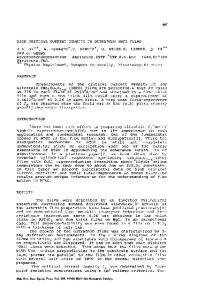YBCO film growth on ultrathin Ag layers
- PDF / 1,261,729 Bytes
- 3 Pages / 576 x 792 pts Page_size
- 17 Downloads / 327 Views
R. Fletcher and E. Moser Wright Laboratory, Materials Directorate, Wright-Patterson Air Force Base, Dayton, Ohio 45433 (Received 5 May 1994; accepted 22 July 1994)
We discuss our results on the growth of YBCO thin films on ultrathin (1-10 nm) Ag underlayers. Substrates were LaAlO 3 . YBCO was sputter deposited and Ag thermally evaporated. It was observed that Tc remained relatively unaffected by the Ag underlayers, ranging from 86-88 K. Critical currents were found to be consistent with YBCO grown on bulk Ag when the Ag underlayer film reached complete coverage (~9 nm). Films grown on Ag showed a marked tendency for microcrystalline growth on the basis of atomic-force microscopy (AFM) results.
I. INTRODUCTION The compatibility of YBCO with metals is an important issue relating to superconductor/normal-metal contacts; fluctuation suppression in wires, tapes, and cavities; contact resistance; SNS systems; and other issues. Outstanding amongst contending metals is Ag which has become the workhorse for these applications due to its chemical/processing compatibility with YBCO and its intrinsically excellent electronic properties. The general goal of the present work was to investigate the electron-transport and material properties of YBCO deposited on Ag underlayers of various thicknesses, in view of the issues above. Specifically, we have measured Tc and Jc as a function of Ag underlayer thickness in the range of 1 to 10 nm, over which partial to full underlayer coverage is spanned. Ag was chosen for the present experiments because it clearly has found a permanent place as an element in the preparation of a variety of YBCO-based material systems. The chemical compatibility of Ag with YBCO is now well known,1 along with its ability to improve Tc and Jc in thick films and bulk material.2-3 The electronic/chemical compatibility of Ag with YBCO is perhaps best exemplified both by bilayer proximity-effect results4 and the novel YBCO/Ag(Au)/YBCO microbridge work of the BTI 5 and NIST 6 groups. In addition, we note that YBCO can be deposited on thick Ag substrates by CVD resulting in T c 's of 85-87 K and J c 's up to 2 X 104 A/cm 2 at 77 K.7'8 Furthermore, Ag has been found to serve as a very effective underlayer for YBCO deposition on stainless steel and Hasteloy where, for laser deposition, Tc's in the range of 83-86 K and / c ' s of up to 7 X 103 at 77 K have been reported,9*11 comparable to results with MgO 12 and YSZ underlayers.13 Ag has also been used as an underlayer for YBCO deposition on Si substrates.14 J. Mater. Res., Vol. 9, No. 11, Nov 1994
In this work we approach the issue of Ag underlayers, in a sense, from the opposite direction: beginning with virgin LaA103 substrates and studying film properties from zero thickness to complete Ag coverage. II. MATERIALS PREPARATION The YBCO films used in this work were prepared by off-axis sputtering on LaA10 3 substrates with or without a previously deposited Ag layer. A typical run consisted of one control substrate without Ag and one with. Substrates were attached t
Data Loading...










